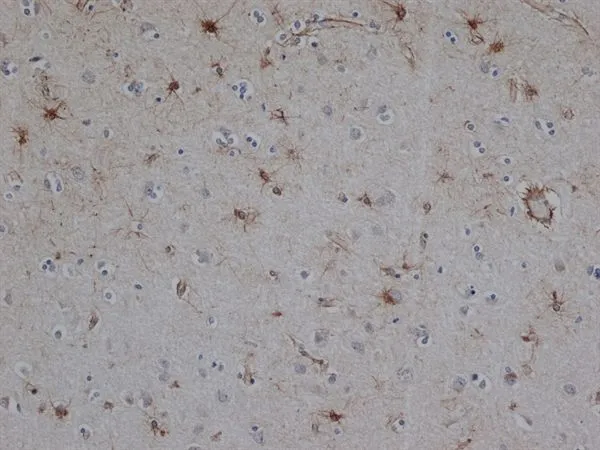
IHC-P analysis of human brain tissue using GTX40996 GFAP antibody. Enzyme mediated antigen retrieval using pronase.
GFAP antibody [1B4]
GTX40996
ApplicationsWestern Blot, ImmunoHistoChemistry, ImmunoHistoChemistry Frozen, ImmunoHistoChemistry Paraffin, RadioImmunoAssay
Product group Antibodies
ReactivityBovine, Canine, Chicken, Guinea Pig, Human, Mouse, Porcine, Rabbit, Rat, Sheep
TargetGFAP
Overview
- SupplierGeneTex
- Product NameGFAP antibody [1B4]
- Delivery Days Customer9
- Application Supplier NoteIHC-P: 1/200-1/1,000. *Optimal dilutions/concentrations should be determined by the researcher.Not tested in other applications.
- ApplicationsWestern Blot, ImmunoHistoChemistry, ImmunoHistoChemistry Frozen, ImmunoHistoChemistry Paraffin, RadioImmunoAssay
- CertificationResearch Use Only
- ClonalityMonoclonal
- Clone ID1B4
- Concentration1 mg/ml
- ConjugateUnconjugated
- Gene ID281189
- Target nameGFAP
- Target descriptionglial fibrillary acidic protein
- Target synonymsglial fibrillary acidic protein
- HostMouse
- IsotypeIgG2b
- Protein IDQ28115
- Protein NameGlial fibrillary acidic protein
- ReactivityBovine, Canine, Chicken, Guinea Pig, Human, Mouse, Porcine, Rabbit, Rat, Sheep
- Storage Instruction-20°C or -80°C,2°C to 8°C
- UNSPSC12352203
References
- Antibody induced seizure susceptibility and impaired cognitive performance in a passive transfer rat model of autoimmune encephalitis.Read more
- Chronic Tear Deficiency Sensitizes Transient Receptor Potential Vanilloid 1-Mediated Responses in Corneal Sensory Nerves. Masuoka T et al., 2020, Front Cell NeurosciRead more
